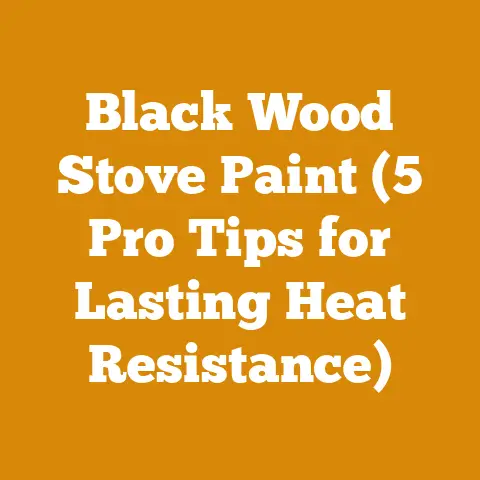Wood BTUs Per Cord (5 Expert Tips You Didn’t Know)
Let’s dive in!
Wood BTUs Per Cord: 5 Expert Tips You Didn’t Know (Until Now!)
Okay, folks, let’s talk firewood. Not just any firewood, but the kind that burns hotter, cleaner, and keeps your home toasty warm all winter long without breaking the bank. I’m talking about understanding and maximizing the BTUs (British Thermal Units) you get per cord. I’ve spent years felling trees, splitting logs, and stacking wood, and let me tell you, there’s a real science (and a bit of art) to getting the most bang for your buck – or in this case, BTU for your buck.
I remember one particularly harsh winter back in ’08. My old wood stove was working overtime, and I was burning through wood like crazy. I thought I was doing everything right, but the house was still drafty. That’s when I started digging deeper into wood species, drying times, and the hidden factors that affect BTU output. What I learned completely changed the way I approach firewood preparation, and it saved me a ton of money (and a lot of shivering!).
This isn’t just about throwing any old log into the fire. It’s about understanding the energy potential locked inside each piece of wood, and how to unlock it effectively. So, grab a cup of coffee, settle in, and let’s get down to the nitty-gritty.
But the devil’s in the details. Not all hardwoods are created equal, and even some softwoods can surprise you.
The BTU Breakdown:
Here’s a quick rundown of some common wood species and their approximate BTU content per cord (at 20% moisture content – more on that later):
- Hickory (Shagbark, Pignut): 27.7 million BTUs/cord – The undisputed king. Burns long and hot.
- Oak (Red, White): 24-27 million BTUs/cord – A very reliable and popular choice.
- Beech: 24 million BTUs/cord – Often overlooked, but a solid performer.
- Maple (Sugar, Red): 20-24 million BTUs/cord – Good heat output and easy to split.
- Ash (White, Green): 20 million BTUs/cord – Burns well even when slightly green.
- Birch (Yellow, Paper): 20 million BTUs/cord – Attractive flame, but burns faster than oak.
- Cherry: 18 million BTUs/cord – Pleasant aroma, but lower BTU content.
- Douglas Fir: 17 million BTUs/cord – A decent softwood option.
- Pine (Yellow, White): 12-16 million BTUs/cord – Burns quickly and creates more creosote.
- Aspen/Poplar: 12-14 million BTUs/cord – Low BTU content, best for shoulder season fires.
Beyond the Numbers: The Hidden Variables
But here’s where it gets interesting. These numbers are just averages. The actual BTU content of a particular piece of wood can vary depending on several factors:
- Tree Age: Older, more mature trees generally have denser wood and higher BTU content.
- Growing Conditions: Trees grown in harsh environments tend to be denser than those grown in ideal conditions. Think of a windswept, rocky hillside versus a sheltered valley.
- Heartwood vs. Sapwood: Heartwood (the inner core of the tree) is generally denser and has higher BTU content than sapwood (the outer layers).
- Specific Gravity: This is a measure of wood density relative to water. Higher specific gravity generally means higher BTU content.
My Experience: I once salvaged some oak from an old barn that had been standing for over a century. That oak burned noticeably hotter and longer than the oak I typically harvest from the forest. It was denser, heavier, and packed with energy. This is why understanding the history of your wood source can be so valuable.
Actionable Takeaway: Don’t just rely on general BTU charts. If possible, learn about the specific growing conditions and age of the trees you’re harvesting. Consider experimenting with different species and keeping track of their performance in your stove.
Tip #2: The Moisture Content Myth – It’s More Than Just “Dry”
This is arguably the most critical factor affecting BTU output. Wet wood doesn’t just burn poorly; it wastes a huge amount of energy. Think about it: before the wood can even start producing heat, the energy has to be used to evaporate all the water inside. That’s energy that could be heating your home going up in steam.
The Ideal Moisture Content:
For optimal burning and BTU output, your firewood should have a moisture content of 20% or less.
Why 20%?
- Efficient Combustion: At this moisture level, the wood will ignite easily and burn cleanly, producing maximum heat.
- Reduced Creosote Buildup: Burning dry wood minimizes the formation of creosote, a flammable substance that can accumulate in your chimney and pose a serious fire hazard.
- Maximum BTU Output: More of the wood’s energy is converted into heat, rather than being used to evaporate water.
How to Measure Moisture Content:
- Moisture Meter: This is the most accurate method. You can purchase a handheld moisture meter for around $20-$50. Simply insert the probes into a freshly split piece of wood and get an instant reading.
- The “Thump” Test: Bang two pieces of wood together. Dry wood will produce a sharp, hollow sound, while wet wood will sound dull and thuddy.
- The “Soap Bubble” Test: Apply soapy water to the end of a split log. If bubbles form when you blow on it, the wood is still wet.
- The Weight Test: Dry wood is significantly lighter than wet wood. After drying for a season, you’ll notice a considerable difference in weight.
My Drying Secrets:
- Split Early, Split Small: Splitting wood exposes more surface area to the air, accelerating the drying process. Smaller splits dry faster than large rounds.
- Stack Properly: Stack your wood in a single row, off the ground (using pallets or scrap wood), and with plenty of space between rows for air circulation.
- Location, Location, Location: Choose a sunny, windy location for your woodpile. South-facing slopes are ideal.
- Top Cover: Cover the top of your woodpile with a tarp or metal sheeting to protect it from rain and snow. Leave the sides open for ventilation.
- The Two-Year Rule (for Hardwoods): In general, hardwoods require at least two summers of drying to reach the optimal moisture content. Softwoods may dry faster.
A Cautionary Tale: I once thought I could get away with burning some wood that had only dried for one summer. It was oak, so I figured it would be okay. Big mistake! The fire smoldered, produced tons of smoke, and barely heated the house. My chimney was coated with creosote, and I had to call a chimney sweep to clean it out.
Actionable Takeaway: Invest in a moisture meter and test your wood regularly. Don’t be tempted to burn wood that isn’t fully dry, even if it seems “good enough.” Properly dried wood will save you money, reduce creosote buildup, and keep your home warmer.
Tip #3: The Cut and Split – Optimizing Surface Area
The size and shape of your firewood splits can significantly impact how efficiently they burn and release their BTUs. It’s all about optimizing surface area.
The Goldilocks Zone:
You want splits that are neither too big nor too small.
- Too Big: Large rounds or unsplit logs take longer to ignite and burn less efficiently. The outer layers may char, but the inner core remains relatively untouched.
- Too Small: Small splits burn quickly and may not provide sustained heat. You’ll find yourself constantly feeding the fire.
The Ideal Split Size:
For most wood stoves, splits that are 4-6 inches in diameter are ideal. This allows for good airflow around the wood, efficient combustion, and sustained heat output.
The Importance of Consistent Splitting:
Consistent splitting ensures that all your pieces burn at a similar rate. This creates a more stable and predictable fire.
My Splitting Strategies:
- Hydraulic Log Splitter: This is my go-to tool for splitting large rounds of hardwood. It’s fast, efficient, and saves my back.
- Maul and Wedge: For smaller rounds and easier-to-split wood, a good maul and wedge are still essential tools.
- Splitting Axe: A splitting axe is designed for splitting wood along the grain, making it a good choice for straight-grained wood.
- Wood Grenade/Kindling Cracker: These are great for making kindling quickly and safely.
The “Bark Up” Rule: When stacking your firewood, place the splits with the bark facing upwards. This helps to shed water and promote air circulation.
A Real-World Example: I once experimented with burning different sizes of oak splits in my wood stove. I found that the 4-6 inch splits burned the most efficiently, producing the highest heat output with the least amount of smoke. Larger rounds smoldered and produced more creosote, while smaller splits burned too quickly.
Actionable Takeaway: Pay attention to the size and shape of your firewood splits. Aim for consistent splitting and optimize for surface area. Experiment with different sizes to find what works best for your stove and wood species.
Tip #4: Stack It Right – Airflow is Your Ally
Proper stacking is crucial for maximizing airflow and promoting even drying. A poorly stacked woodpile can trap moisture, leading to rot and reduced BTU output.
The Key Principles:
- Off the Ground: Elevate your woodpile using pallets, scrap wood, or cinder blocks. This prevents moisture from wicking up from the ground.
- Single Row Stacking: Stack your wood in a single row, rather than a large, dense pile. This allows for maximum air circulation.
- Space Between Rows: Leave at least 4-6 inches of space between rows to allow for airflow.
- Orientation: Orient your rows perpendicular to the prevailing wind direction. This will maximize air circulation through the pile.
- Top Cover: Cover the top of your woodpile with a tarp or metal sheeting to protect it from rain and snow. Leave the sides open for ventilation.
- Avoid Stacking Against Walls: Stacking wood directly against a wall can trap moisture and promote rot.
Stacking Patterns:
There are many different stacking patterns you can use, but the most important thing is to ensure good airflow. Some popular patterns include:
- The Simple Row: This is the most basic pattern, simply stacking the wood in a single row.
- The Holzhaufen: This is a traditional German stacking method that creates a circular pile with a central chimney for ventilation.
- The Rick: This involves stacking the wood in a rectangular pile with alternating layers of wood facing in different directions.
My Stacking Philosophy: I prefer the simple row method, as it’s easy to implement and provides excellent airflow. I also make sure to leave plenty of space between rows and to orient my rows perpendicular to the prevailing wind.
The Rot Factor: I once neglected to elevate my woodpile off the ground, and the bottom layer of wood rotted before I could even burn it. This was a costly mistake, and it taught me the importance of proper stacking.
Actionable Takeaway: Pay attention to how you stack your firewood. Elevate it off the ground, stack it in a single row, and leave plenty of space between rows for airflow. Use a top cover to protect it from rain and snow.
Tip #5: Beyond the Cord – Understanding “Face Cord” and Other Measurements
The term “cord” is often misused and misunderstood. It’s important to know what a cord actually is, and how it compares to other measurements like “face cord” or “rick.”
What is a Cord?
A cord is a precisely defined unit of measurement for firewood. It’s defined as a stack of wood that measures 4 feet high, 4 feet wide, and 8 feet long, totaling 128 cubic feet.
The Face Cord (or Rick):
A face cord (also sometimes called a rick) is not a standardized unit of measurement. It’s simply a stack of wood that is 4 feet high and 8 feet long, but the depth (the length of the splits) can vary. This makes it difficult to compare prices and BTU content between different face cords.
The Danger of the Face Cord:
The problem with face cords is that they can be easily misrepresented. A seller might claim that a face cord is “one-third of a cord,” but if the splits are shorter than 16 inches, it’s actually less than that.
Calculating the True Volume:
To determine the true volume of a face cord, you need to know the length of the splits. Multiply the height (4 feet) by the length (8 feet) by the depth (the length of the splits in feet). This will give you the volume in cubic feet. Divide this number by 128 to get the equivalent in cords.
Example:
A face cord that is 4 feet high, 8 feet long, and has 16-inch splits (1.33 feet) has a volume of 42.56 cubic feet. This is equivalent to 0.33 cords (42.56 / 128 = 0.33).
My Rule of Thumb:
When buying firewood, always ask for the price per cord, not per face cord. If the seller only offers face cords, be sure to measure the length of the splits and calculate the true volume to ensure you’re getting a fair price.
A Price Comparison:
Let’s say you’re offered a cord of oak for $300, or a face cord of oak (with 16-inch splits) for $120. Which is the better deal?
- The cord costs $300 for 128 cubic feet of wood.
- The face cord costs $120 for 42.56 cubic feet of wood.
To compare, let’s calculate the cost per cubic foot:
- Cord: $300 / 128 cubic feet = $2.34 per cubic foot
- Face Cord: $120 / 42.56 cubic feet = $2.82 per cubic foot
In this case, the cord is the better deal, even though the face cord seems cheaper at first glance.
My “Cord Confidence” Story: I once bought what I thought was a “full cord” of wood from a local seller, but when I stacked it, it was noticeably smaller than a cord. I measured the dimensions and discovered that it was actually only about three-quarters of a cord. I contacted the seller and politely explained the discrepancy, and he agreed to give me a partial refund. This experience taught me the importance of knowing what a cord is and how to measure it accurately.
Actionable Takeaway: Understand the difference between a cord and a face cord. Always ask for the price per cord, and be sure to measure the dimensions of any face cords you’re considering buying to ensure you’re getting a fair price.
Bonus Tip: The Creosote Connection – Burn Clean, Burn Safe
Creosote is a byproduct of incomplete combustion that can accumulate in your chimney and pose a serious fire hazard. Burning dry wood, maintaining proper airflow, and cleaning your chimney regularly are essential for preventing creosote buildup.
The Creosote Cycle:
- Incomplete Combustion: When wood doesn’t burn completely, it releases unburned gases and particles.
- Condensation: These gases and particles condense on the cool surfaces of your chimney.
- Creosote Formation: Over time, the condensed gases and particles harden into creosote.
- Fire Hazard: Creosote is highly flammable and can ignite, causing a chimney fire.
Preventing Creosote Buildup:
- Burn Dry Wood: This is the most important factor. Dry wood burns cleaner and produces less creosote.
- Maintain Proper Airflow: Ensure that your wood stove has adequate airflow to promote complete combustion.
- Burn Hot, Not Slow: Avoid smoldering fires, as they produce more creosote.
- Regular Chimney Inspections: Have your chimney inspected by a qualified professional at least once a year.
- Regular Chimney Cleaning: Clean your chimney regularly to remove any accumulated creosote.
My Creosote Scare: I once had a small chimney fire caused by creosote buildup. It was a terrifying experience, and it taught me the importance of regular chimney maintenance. I now clean my chimney at least twice a year, and I’m much more careful about burning dry wood and maintaining proper airflow.
Actionable Takeaway: Take creosote seriously. Burn dry wood, maintain proper airflow, and clean your chimney regularly to prevent creosote buildup and reduce the risk of a chimney fire.
Putting It All Together: A Firewood Masterclass
So, there you have it – my top 5 (plus a bonus!) expert tips for maximizing the BTUs you get per cord of firewood. It’s not just about the type of wood you burn; it’s about the entire process, from selecting the right species to properly drying, splitting, and stacking your wood.
By following these tips, you can:
- Save Money: Burn less wood and get more heat.
- Reduce Creosote Buildup: Minimize the risk of chimney fires.
- Keep Your Home Warmer: Enjoy a more comfortable and efficient heating experience.
- Be a More Responsible Wood Burner: Minimize your environmental impact.
Remember, firewood preparation is a marathon, not a sprint. It takes time, effort, and a little bit of know-how. But the rewards are well worth it – a warm home, a safe chimney, and the satisfaction of knowing you’re getting the most out of your wood.
Now, get out there, get splitting, and get stacking! And remember, stay warm and stay safe.






